10/22/2023 – Well, we moved Real Guns, in its entirety, to a new service with new dedicated servers. One big 267 gigabyte tarball that went from an Intel/CentOS 7 platform to more storage and processing power AMD/ AlmaLinux 9 platform… all shiny and new.
CenOS 7 ended its development life in January 2022, and would not longer be supported in any way beyond July 2024. Additionally, our previous hosting service switched to Zen Desk support, which is the equivalent of “Did you reboot your system” support for Linux based commercial customers. There were some exciting moments during the move.
We had to reset our domain records and make entries for the new. Unfortunately, the reset and update did reset on the new servers, but did not update. Then, with everything running well, the mail server decided to stop talking to the outside world, and began bouncing incoming mail like paddle throttled ping pong balls.
The sole casualty of the move, was an in-process article that missed the cutoff for transfer. I keep seeing it in black and white, chasing the transfer train down the tracks as it pulls away, until the file finally flops and falls on its face in exhausted desperation.
The loss is a shame, since it was no doubt the best and most interesting article I have ever written… in my entire life. The supporting photography was Henri Cartier-Bresson quality. And it was humorous… but not tacky obvious humor. We’re talking clever, insightful, sophisticated humor. And the grammar and punctuation was PERFECT.
Unfortunately, I cannot recall the details of that work well enough to recreate it, and I had formatted the thumb drive with all of the images. I know. We’ll all have to somehow cope with the loss. But trust me, it was good.
The cult of the metallophobia
Every time I write about 1 1911 type, I am met with the same barrage from plastic fantastic fans, attacking the 1991’s magazine capacity, single action operation, and general use of metal. The critiques come via email, Facebook comment and, one time, as a singing telegram. The performance was actually pretty good… more of an anthology, but with excellent costume and atmospheric effects.
My favorite response to one of my post regarding the 1911 is “I prefer the poly…”, Who cares, I didn’t ask. Believe it or not, as to the question of “What is a good handgun selection?”, there is more than one correct answer, as there are many applications, and people personalities, and preferences, and aesthetic sensibilities.
Losing one’s handgun virginity
My first experience with a 1911, was with a pre A1, government issued, 1911 round top. That was in ’57 or ’58, which made me eleven or twelve years of age. I basically recall a lot of noise, a lot of muzzle jump, and minimal damage to a very large target some twenty five yards distant. Maybe if it didn’t repeatedly bite my hand, maybe if I was wearing ear protection, it would have been a different experience. I set handguns aside for the next dozen years or so.
It is interesting that, in those days, the 45 Automatic was considered a vicious wrist breaker and incredibly powerful. The 45 Auto was talked about in sordid stories, where one round of dreaded ball ammunition would kill a human, regardless where they were struck, while knocking them to the ground.
Life in America after war…s
Back in those days, civilian handguns often came home with returning WW II and Korean War vets as souvenirs, where they were relegated to shoe boxes on the top shelf of a bedroom closets. Neighborhood crime, by today’s standards, was non existent.
Firearm ownership was focused upon rifles and shotguns, and predominately associated with hunting and competitive shooting. Military surplus rifles that were sold cheap from discount department stores were quickly sporterized and repurposed for hunting and recreational target shooting.
Then the war in Vietnam and the 60s happened, more vets returning home, the nature of American society began to change, some for the better, some not so much, and the need for home defense and self defense began to emerge as essential. Proficiency shooting spawned competitive shooting, and the use of handguns flourished. I purchased my first 1911 type 45 Automatic in 1971 at the age of twenty five.
My 70 Series Gold Cup Colt came at the tail end of Colt’s historical reputation. Having weathered business failures and political fallout over Colt’s anti Second Amendment posturing, the late 1980s and 1990s fostered substandard Colt quality and misdirected design evolution, which brought an end to their run as a prestigious brand. Independent manufacturers picked up the design, adding tweaks and refinements popular with the 1911 market.
Trends came and went, theories were advanced and disproved, as did companies that strayed too far from the basic design. Today, a good 45 Automatic is one that does not foster non-standard components and features. The best are those that do not stray from the Series 70 configuration.
Ruger’s tribute to John M. Browning
The Ruger SR1911 product is all American made, from piece parts to final product. The SR1911 is predominately a 70 Series type, devoid of firing pin plunger trigger blocks and associated levers and linkage and with the presence of hammer hooks. It does, however, have a solid barrel bushing rather than collet. The target model, pictured, is a round top with fully adjustable rear sights, and a dovetail base front sight, rather than staked, as was the case with the Series 70s.
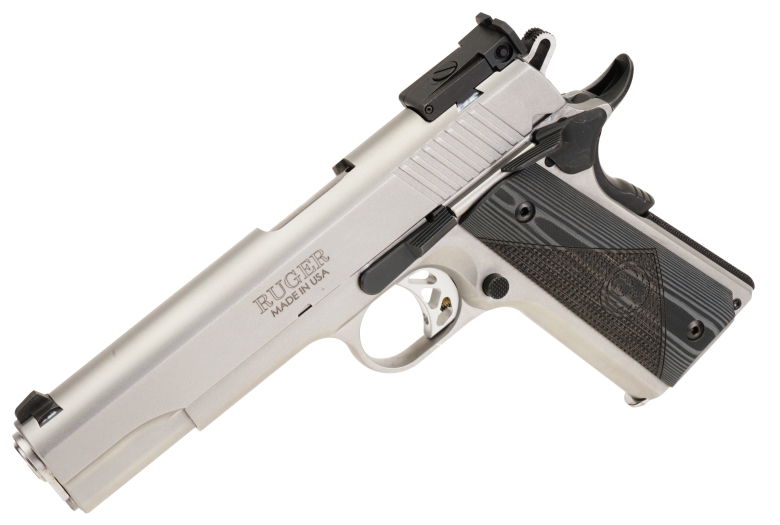 The slide is clean with only rear serrated grasping surfaces. The magazine release is extended outward for folks who do not have foot long thumbs, the slide stop extends outward for improved purchase, the thumb safety is ambidextrous and the wings are narrow.
The slide is clean with only rear serrated grasping surfaces. The magazine release is extended outward for folks who do not have foot long thumbs, the slide stop extends outward for improved purchase, the thumb safety is ambidextrous and the wings are narrow.
The plunger tube that provides detents for the slide release and thumb safety is integral to the frame, rather than a separate staked on piece.
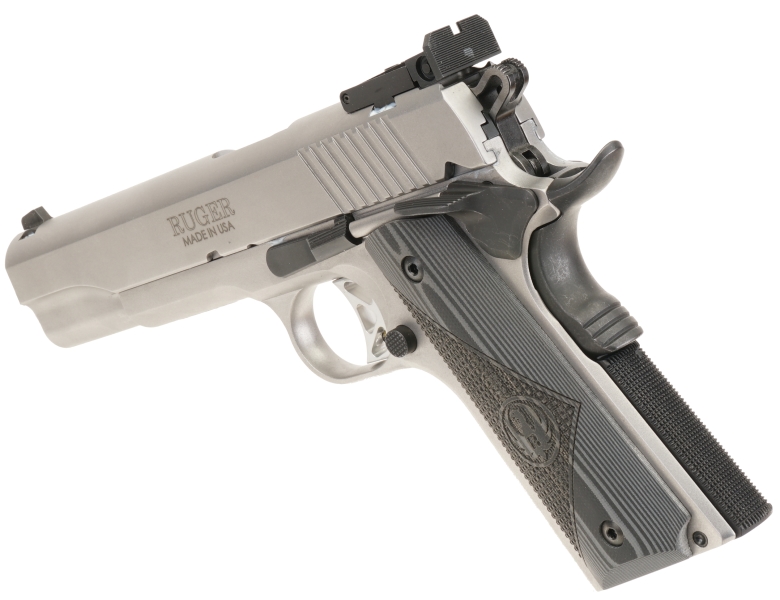 The sights are matte black and serrated to kill reflections and glare. The small blob on the rear sight is from me handling the sights with gun lube on my thumb. The grip safety has a speed bump to assure safety release when gripped. The mainspring housing is sharply checkered polymer, the front strap is smooth.
The sights are matte black and serrated to kill reflections and glare. The small blob on the rear sight is from me handling the sights with gun lube on my thumb. The grip safety has a speed bump to assure safety release when gripped. The mainspring housing is sharply checkered polymer, the front strap is smooth.
| Ruger SR1911 Target |
|
| Company | Ruger |
| Model # | 6736 |
| Manufacture | Prescott, AZ |
| Type Action | Single Action |
| Slide | Stainless Steel |
| Finish – Barrel/Side | Low Glare |
| Frame | Stainless Steel |
| Caliber | 45 Auto |
| Capacity | 8+1 |
| Barrel Length | 5.0“ |
| Twist | 1:16″ RH |
| Weight – Empty | 30 oz |
| Overall Length | 8.67″ |
| Overall Height | 5.45″ |
| Sights – Rear | Adj W/E Serrated Face |
| Sight – Front | Black – Drift Adjustable |
| Sight Radius | 6.85“ |
| Trigger Pull | 4 lbs 3 oz (Actual) |
| MSRP | $1269 |
| Includes hard case, 7 and 8 round magazines, lock, and manual | |
Out of the box or hot rodded
The SR1911 is 100% made in U.S.A., from its cast stainless steel frame produced at Ruger’s Pine Tree foundry, to the side forged and machined from bar stock, to all of the piece parts incorporated in the finished assembly. Barrels and bushings are also made in house.
MIMs the word…
As is the case with virtually all quality manufacturers that want to offer firearms at competitive prices, and stay at business, manufacturing technology must play a vigilant role. In this case, the use of MIM components.
MIM, Metal Injection Molding, is a cost effective way of producing small and medium size complex geometric shaped. Powdered metal and binders, wax and polymers, are combined as pellets. The pellets are passed through an injection molding process and formed into parts.
The green parts are subjected to a debinding process that separates the metal parts from the wax and polymers so predominately only metal is left. Those parts then are passed through a sintering step where the part is raised near the melting point of the metal, any residual binder is removed and the parts cures. The MIM part can than be treated to final processing; machining, heat treating, plating. Dimensions of MIM parts can be held to 0.0005″.
The Ruger SR1911 is a great shooter right out of the box, and it will continue to perform as well for a very long time. The problem with MIM parts is me, because I tend to tinker with my firearms. As an example, I like 3 lb triggers on my 1911s, which means subjecting parts to refining contact part finishes, changing contact angles, polishing.
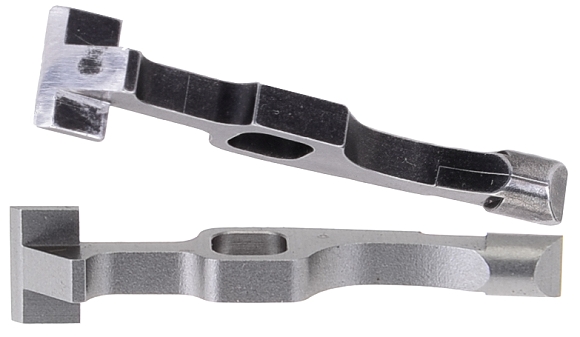
With some MIM parts, there are parting lines or gate marks that can’t be removed while maintaining proper part dimensions, or without cutting through surface hardening. Above, the MIM disconnector top, tools steel part below. Fortunately, the SR1911 accepts after market parts with minor fitting, so it is easy to change to tool steel aftermarket pieces. Again, this is not a shortcoming with the Ruger, nor is this necessary to get many years of service from the SR1911.
The Ruger SR1911 can be Super…
The 45 Super is a good variation of the 45 Automatic and, with minor changes, the Ruger handles the round well. Real Guns did a three part series on this, not long ago. Below, links to detail of part changes and 45 Super handload data.
Making Ruger’s SR 1911 Standard, Super Part I
Making Ruger’s SR 1911 Standard, Super Part II
Making Ruger’s SR 1911 Standard, Super Part III
One of the good ones
Within the group of handguns I own, there is a variety; steel, poly, big and small bore, auto loader and revolver, single shot, and bolt action. Each intended to meet the needs of a specific application. One cannot meet all. However, I will always own at least one 1911.

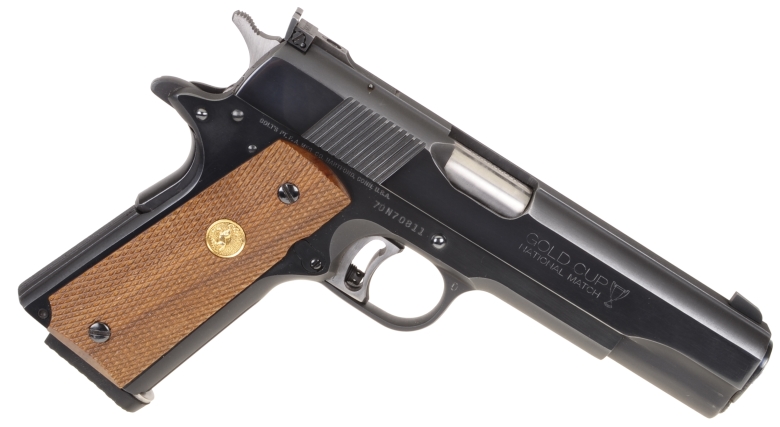
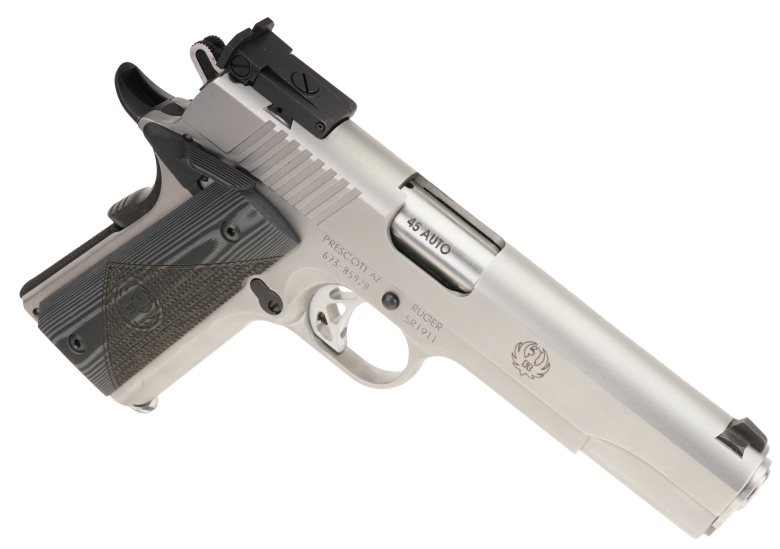
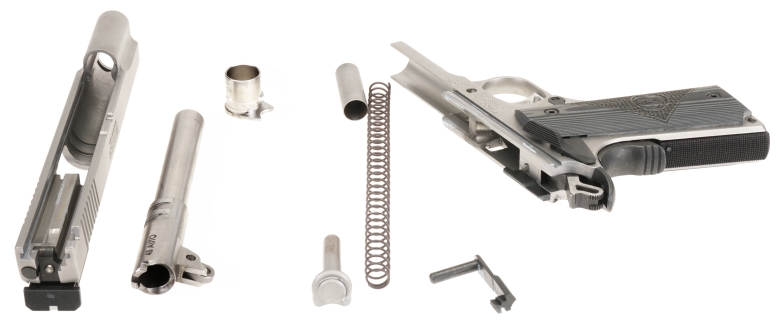
Email Notification